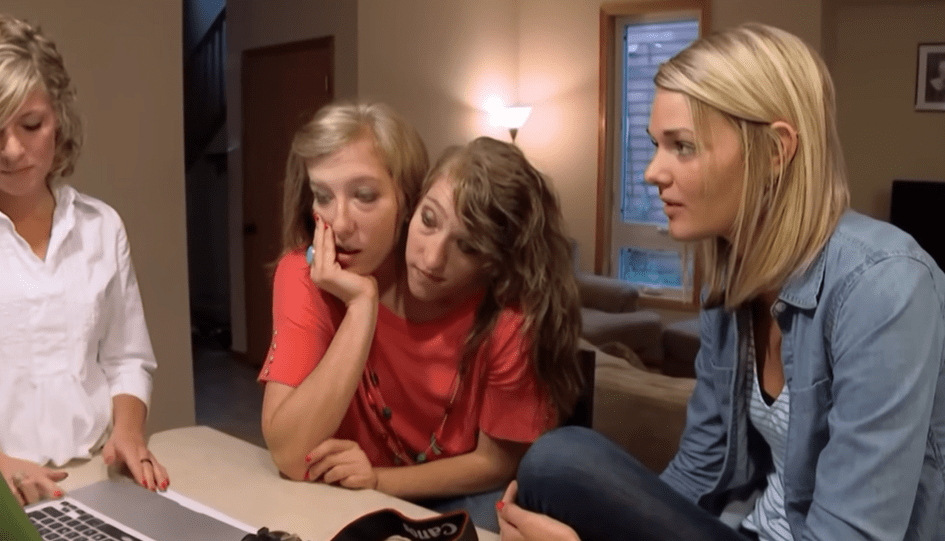Few people can understand the life that Abby and Brittany Hensel have spent decades leading, and even fewer would persevere with such grace. Despite being born in 1990 with dicephalic parapagus, a rare condition in which two heads share one body, they have never complied with social norms or standard medical expectations. They have made the decision to create a new normal rather than living as an exception. Their shared life is characterized by strategy, adaptation, and an unwavering bond that has changed public perception over time, rather than by limitations.
The twins had a particularly important surgery at Gillette Children’s Specialty Healthcare when they were twelve years old. Separation had been ruled out early because of its high risk, but this procedure wasn’t about that. Instead, in order to improve respiratory function, doctors tried to expand their chest cavity and correct scoliosis. Considering the distinct anatomical structure involved, the decision to move forward with this type of intervention was not made hastily. However, the outcomes—posture stabilization, improved breathing, and noticeably increased long-term comfort—were strikingly successful. It was an instance of medicine enhancing quality of life rather than changing identity.
Hensel Twins – Bio & Key Details
| Aspect | Details |
|---|---|
| Full Names | Abigail Loraine Hensel and Brittany Lee Hensel |
| Date of Birth | March 7, 1990 |
| Birthplace | New Germany, Minnesota, USA |
| Medical Condition | Dicephalic parapagus twins (two heads, one body, shared organs below the waist) |
| Early Surgery (Age 12) | Operation for scoliosis correction and chest expansion to support better lung function |
| Decision on Separation | Declined due to extremely high risk—survival for both twins unlikely |
| Career | Fifth-grade teachers in Minnesota |
| Media Presence | TLC documentary series Abby & Brittany (2012) |
| Recent Milestone | Abby Hensel’s marriage to a U.S. Army veteran (reported in 2024) |
| Reference Link | Wikipedia – Abby and Brittany Hensel |
Less than 25% of conjoined twins survive long enough to even be considered for surgical intervention, and they occur about once in every 200,000 live births. The Hensels have already overcome extraordinary odds by simply surviving into adulthood. Their organ configuration—each has a heart and spinal cord, but their bodies are completely shared below the waist—led the medical community to decide against separating them. Separating them would have put at least one twin at risk for long-term systemic failure in addition to immediate death.
The surgery at age 12 became a particularly creative solution because it concentrated on improving functionality rather than causing separation. In addition to preventing worsening skeletal misalignment, which would have severely limited mobility, it allowed both girls to breathe more freely. Conjoined twins, particularly those who share a body to this extent, can benefit greatly from even small improvements. The Hensels were spared the trauma of an irreversible surgical gamble thanks to this incredibly effective medical intervention, which allowed them to continue living a full, unburdened life.
Because of their appearances on Oprah and their own reality shows, Abby and Brittany became well-known, not as objects of interest but as teachers, daughters, and people. The focus on Abby’s marriage in recent years has rekindled discussions about privacy, autonomy, and the complexities of identity in combined lives. As the story developed on various media outlets, some people expressed their admiration while others made intrusive inquiries. Nevertheless, the twins maintained their composure and handled criticism with the same poise they had displayed since they were young.
Their story is an interesting case study in the context of changing medical ethics. It reflects choices made by other conjoined twin families, like the parents of twins who were split up in Germany in 2024—an operation that only saved one child’s life. The Hensels represent an alternative viewpoint, even though stories like these frequently spark discussions about risk and reward: sometimes the bravest course of action is to learn to live together rather than apart.
The Hensel twins have created a meaningful life that goes far beyond what early diagnoses might have suggested through strategic cooperation with educators, medical professionals, and their support system. By deciding to become teachers, they actively influence how kids view differences from a young age in addition to challenging societal norms. Children see diversity through everyday human interaction rather than medical charts, and their influence in the classroom is incalculable.
The way society views disability has changed significantly in the last ten years. A wider culture of acceptance has been facilitated by visibility campaigns, inclusive education policies, and public figures who have been candid about their circumstances. Abby and Brittany have established themselves here as active participants in the process of change rather than merely passive recipients of care. Their choice to forego separation surgery has turned out to be both socially and medically sound.
Even though their illness is uncommon, the lessons they teach—how to adjust, advocate, speak up, and redefine success—are remarkably similar to those faced by anyone dealing with long-term health complexity. Their synchronization, whether it be through walking coordination, email typing, or lesson planning, is a silent kind of genius that is based on communication, rhythm, and trust.
Their short, accurate, and purposefully condensed surgical history highlights a fundamental medical reality: not all interventions must be drastic in order to have a transformative effect. Listening intently to the patient, adjusting to their lived reality, and making decisions that improve life rather than trying to change it can sometimes have the most lasting effects.
Future conjoined births may become more feasible in the years to come thanks to developments in regenerative medicine and surgical robotics. However, the Hensels serve as a reminder that the restoration or separation of anatomical “normalcy” is not always a reliable indicator of medical success. Their shared body is a life lived uniquely—and well—rather than a problem to be solved.







